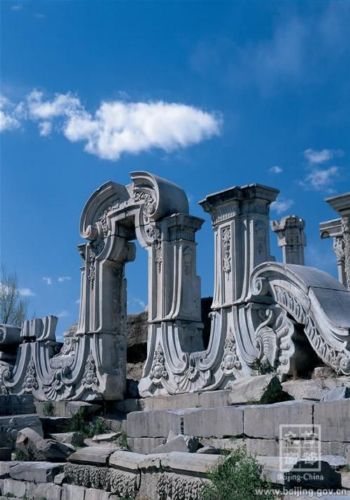


The Ruins of the Yuanmingyuan, also known as the Garden of Perfection and Brightness, is located northwest of Beijing and east of the Summer Palace. The Garden was first constructed in 1709 during the reign of Emperor Kangxi of the Qing Dynasty (1644-1911).
Over the next 150 years, the Garden was expanded as a large-scale Chinese emperors' private pleasure garden, covering 350 hectares (over 864 acres). British and French troops destroyed it in the late 19th century; which has been deserted ever since.
The Garden originally had a great lake in the middle of it, and surrounded by Nine Islets. Various temples and pavilions are scattered around. Artisans have borrowed various sights from all over the country, including garden architecture from Suzhou, mountain scenery from Huangshan and the temple and monastery buildings as well. Be prepared to walk and feast your eyes on its distinctive architecture.
The islets can be divided into three gardens: the western section - Yuanmingyuan (Garden of Perfection and Brightness), southern Changchunyuan (Garden of Eternal Spring) and eastern Wanchunyuan (Garden of Eternal Spring). You will find the European Garden with its Great Fountain Ruins in Changchunyuan (Garden of Eternal Spring), which is considered the best-preserved relic in the palace.
Yuanmingyuan Garden is the largest of the three gardens, boasting of 48 scenic spots, which are divided into smaller areas. Construction inside the garden include Zhengda Guangming Hall, where emperors handled political affairs; Jiuzhou Qingyan Hall where the imperial family dined; Anyou Palace where sacrificial ceremonies were held; Wenyuan Pavilion where books were stored; and Broken Bridge, Fallen Snow, a scenic spot imitating the style of West Lake. The garden holds numerous books, calligraphies, paintings, and treasures.
Hundreds of scenic spots in the Garden are made up of exquisitely constructed halls, pavilions, chambers, kiosks, earth and rock hills, rivers and ponds, and exotic flowers and grasses from different parts of the country. It embodies Chinese ancient landscape gardening.
Emperors and empresses of the late Qing lived luxurious lifestyles at the palace, spending money excessively. In the 10th year (1860) of Emperor Xianfeng, the English and French armies invaded Beijing and burned the palace to the ground. The remaining carved stone columns are a reminder of the crimes committed by imperialist powers.
For 16 years, celebrating the opening of thousands of lotuses at the Old Summer Palace has been a summer treat for people in the city. Throughout July and August, the park features a green and pink backdrop for a series of programs, including dancing and singing as lotus carnival launches its first music festival. Pop singers and local bands perform along the bank of the lakes in the garden, while visitors can enjoy boating in a sea of lotus.
Address: 28 Qinghua Xilu, Haidian District
Tel: +86 10 6262 8501
Open: 7 a.m. 9 p.m.(May-August)
7 a.m.-8:30 p.m. (April, September, October)
7 a.m.-7:30 p.m. (January-March, November and December)
Admission: 10 yuan
Traffic: Bus Nos. 320, 331, 365, 375, 722 and 825